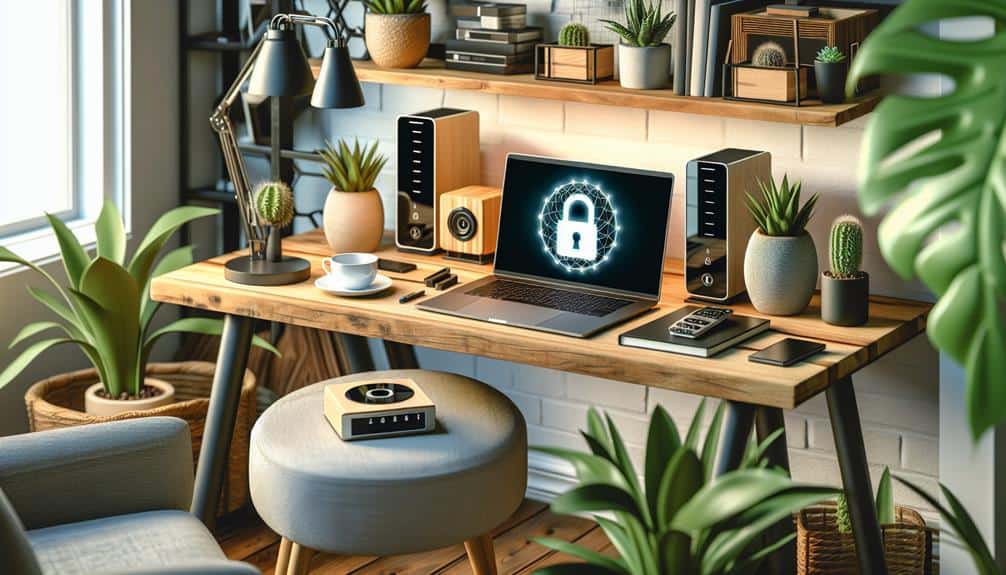
free shipping on orders over $25
We’re having a sale on all our products. Enter your email below to be notified about future sales.


We’re having a sale on all our products. Enter your email below to be notified about future sales.


You need to fortify your home office against increasing cyber threats. Start by securing your home network—use a VPN to encrypt your data and strengthen Wi-Fi passwords. Don’t forget physical security; install security bars, smart locks, and window sensors. Implement two-factor authentication for all your online accounts to enhance security significantly. Also, make sure you’re regularly backing up your data to fend off potential data losses from cyberattacks. These steps aren’t just crucial; they’re your first line of defense in safeguarding your professional sanctuary. More insights await to further bolster your security setup.
As remote work has surged, so too have the risks associated with your home office security. You’re among the millions embracing the flexibility of working from home, but this shift has significantly increased your exposure to cyber attacks. The stats are alarming: remote workers are the target of 67% of cyber attacks, making you more vulnerable to unauthorized access and potential data breaches.
The types of threats you face are varied, with phishing attacks being particularly prevalent. These deceptive maneuvers are designed to steal sensitive information or infect your systems, and their frequency has soared by 238% since the rise of remote work. This spike highlights the urgent need for robust security measures in your home office.
As an employee operating remotely, it’s crucial to understand these security risks. Cybersecurity isn’t just an IT issue—it’s your responsibility too. Adopting effective security practices can shield you from the dire consequences of a breach. Remember, a secure home office not only protects your data but also supports the overall safety of the organization you work for. Therefore, staying informed and vigilant is the first step towards safeguarding your digital workspace from these escalating threats.
To enhance your home office’s physical security, consider implementing several effective measures. First, installing security bars on ground floor windows can significantly reduce the risk of unauthorized access. These bars provide a sturdy barrier against intruders, ensuring your workspace remains secure.
Additionally, enhancing outdoor lighting near your office entrance can deter potential intruders. Bright, well-placed lights make it difficult for unwanted visitors to approach unnoticed, adding an extra layer of security.
Incorporating window sensors is another smart move. These devices alert you to any attempts to breach your home office, giving you time to react and notify authorities if necessary. Pair these sensors with smart locks on your doors for superior access control. Smart locks allow you to manage entry to your workspace conveniently, ensuring that only authorized individuals can enter.
Lastly, don’t overlook the importance of securing your important documents. Keep them in a locked cabinet to safeguard sensitive information from falling into the wrong hands. This practice not only protects your documents but also maintains the integrity of your professional and personal data. By taking these steps, you’ll fortify your home office against potential threats, maintaining a safe and productive work environment.
After securing the physical aspects of your home office, it’s equally important to protect your online activities by securing your home network. As a remote worker, the integrity of your home network is paramount, especially when handling sensitive data. With the surge in remote work since 2021, cybersecurity measures have become more crucial than ever.
One of the most effective tools you can use is a Virtual Private Network (VPN). A VPN encrypts your internet traffic, creating a secure tunnel for your data. This is essential, particularly when you’re tempted to connect to public Wi-Fi, which is significantly less secure and more susceptible to cyber threats. By using a VPN, you mimic the security standards of corporate networks, shielding your activities from prying eyes.
Ensure all your devices are connected through this secure network, especially when accessing company information. This setup not only helps in protecting against potential cyber attacks but also ensures your data privacy remains intact. Remember, securing your home network isn’t just a recommendation; it’s a necessity in today’s digital age where your office extends into your home.
You should consider implementing strong authentication, such as two-factor authentication (2FA), to significantly reduce the risk of unauthorized access to your accounts. This method involves a second layer of security that goes beyond just a password, requiring something you know plus something you have, like a code sent to your mobile device. It’s a robust security measure that enhances your account security, especially for both personal and work-related online accounts.
With cyber threats on the rise, 2FA plays a crucial role in safeguarding sensitive information. It’s not just about protecting personal data anymore; in a remote work environment, the security of business data is also at stake. By adopting strong authentication methods like 2FA, you’re taking a proactive step against potential breaches.
Navigating the complexities of shared spaces is essential for remote workers aiming to maintain data security at home. With 42% of you sharing your workspace with others, the risk of unauthorized access to your work materials significantly increases. To tackle these security challenges, it’s crucial to strike a balance between physical and digital security measures.
Firstly, establish clear boundaries. It’s important to delineate your workspace from the rest of the shared areas. This isn’t just about physical space—it’s also about setting times when your workspace is off-limits to housemates or family members. Clearly communicating these guidelines ensures that everyone respects your work environment.
To further mitigate risks, consider physical security enhancements like locking file cabinets or securing devices with password-protected screens when not in use. These simple steps can prevent unauthorized access and protect sensitive information.
To safeguard your online activities, using a Virtual Private Network (VPN) is essential for encrypting your internet traffic and protecting sensitive data. As you work from home, adopting a VPN isn’t just a luxury; it’s a critical component of your online security strategy. It ensures that your personal and professional information remains confidential, shielding it from potential cyber threats.
When you connect to a VPN, your connection to the internet is secured, creating a private tunnel for your data. This secure connection is crucial, especially when accessing company networks or handling sensitive tasks. It’s similar to being physically present in your office, where you’re protected by the company’s robust security measures.
Moreover, for remote workers, a VPN is vital to improve online security. It masks your IP address, enhancing your online privacy by making your actions virtually untraceable. This is particularly important in today’s digital age, where data breaches and online surveillance are rampant. By encrypting your internet traffic, a VPN ensures that your personal and work-related activities remain secure from prying eyes, thus boosting your overall data protection while you continue to efficiently manage your professional responsibilities from any location.
Protecting your sensitive information is crucial as remote work environments are particularly vulnerable to cyberattacks. With 67% of IT professionals reporting breaches due to remote work, it’s evident that security controls are essential.
When you’re working remotely, unauthorized access and phishing emails are significant threats. These can lead to security breaches, exposing sensitive information that can severely impact your work and personal life.
To safeguard your data, start with robust password protection on all devices and accounts. Ensure that you’re using complex passwords and change them regularly. Additionally, employ multi-factor authentication wherever possible, adding an extra layer of security that can deter cybercriminals.
Since remote employees often use home networks, it’s vital to secure these with strong Wi-Fi passwords and by enabling network encryption. Use a Virtual Private Network (VPN) to encrypt your internet connection, making it harder for hackers to intercept the data you send and receive. This is particularly important when accessing company resources or handling sensitive information.
Regularly backing up your data is essential to safeguard against potential data loss from system failures or cyberattacks. By implementing strategic data backup practices, you’re not only protecting your work but also ensuring business continuity. It’s crucial to adopt a combination of automated backup solutions and regular testing of data recovery procedures. This way, you’ll minimize downtime and ensure your data can be quickly restored when needed.
Automating your backups removes the risk of human error and ensures that your data is backed up consistently. It’s also important that you’re encrypting backup files to protect sensitive information from unauthorized access. Remember, storing backups off-site protects against physical threats like theft or natural disasters, further securing your data.
Below is a table summarizing key aspects of effective backup strategies:
| Strategy Component | Why It’s Important |
|---|---|
| Automated Backup | Ensures regular, error-free backups |
| Testing Recovery | Confirms backups can be restored effectively |
| Off-site Storage | Guards against local physical threats |
| Encrypting Files | Secures data from unauthorized access |
| Regular Updates | Keeps backup practices aligned with current threats |
Adhering to these guidelines will bolster your defense against system failures and cyber attacks, ensuring you’re well-prepared for any data-related emergencies.
As you explore ways to safeguard your business, consider cybersecurity insurance, a critical tool that provides financial protection against cyber threats and data breaches. This insurance isn’t just a safety net but a crucial part of your risk management strategy, helping you mitigate losses from unforeseen cyber attacks.
Here are four key coverage options you should know about:
Assessing your cyber risk exposure and choosing the right cybersecurity insurance will fortify your defenses and support your long-term success.
To ensure your company’s security and compliance, you must implement remote work compliance measures effectively. This involves setting up stringent security protocols and data protection policies that safeguard sensitive company information in remote work environments. By doing so, you’ll significantly reduce the risk of cyber threats and regulatory violations.
Key compliance measures include training employees thoroughly. They need to understand the importance of data security and how their actions can impact the overall safety of company data. This training should cover how to handle sensitive information securely and identify potential security breaches.
Furthermore, it’s vital to monitor remote work activities closely. This oversight ensures that all employees adhere to the established data protection policies and compliance measures. Regular audits and checks can help detect any deviations from these standards early, preventing potential data breaches.
To protect your remote work, you’ll need VPN utilization, encrypted communications, and two-factor authentication. Also, ensure secure Wi-Fi, robust firewalls, password management, phishing training, device encryption, antivirus software, and secure backups.
To secure your home office, install physical locks, surveillance cameras, and window alarms. Use secure Wi-Fi, anti-spyware software, and privacy screens. Shred documents, lock drawers, utilize backup drives, and store valuables in personal safes.
To secure your company’s system at home, use secure VPNs, enable encryption software, and configure firewalls. Regular antivirus updates, patch management, and strict access controls are essential. Consider biometric authentication for enhanced security.
To keep data secure with remote employees, use encryption software, virtual private networks, and secure Wi-Fi. Implement biometric authentication, two-factor authentication, access controls, and secure browsers. Conduct regular audits and provide phishing training.
Para Bellum Defense
190 Chambers Street
Spencerport, NY 14559
Telephone: 585-284-6669

I like this blog it’s a master piece! Glad I noticed this
ohttps://69v.topn google.Raise your business